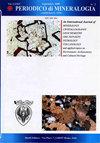AISI 1045钢棒的渗硼和感应硬度评定
IF 1.2
4区 地球科学
Q3 GEOCHEMISTRY & GEOPHYSICS
引用次数: 0
摘要
温度对材料的性质和结构有重要的影响。本研究对AISI 1045中碳钢棒样进行渗硼和后续的感应淬火回火,以提高表层硬度。感应线圈用于在钢棒表面添加硼膏成分。测试是用来评估处理过的钢棒的硬度和显微组织。在不同的温度、停留时间和进料速率下,共测试了30个样品,以确定处理后样品的硬度。作为回火过程的一部分,田口优化在炉中进行,以确定消除内应力的最佳参数值。两种类型的仪器用于检查材料的化学成分及其微观结构:扫描电子显微镜(SEM)和光学显微镜。由于马氏体组织的出现,硬度值提高了。在800°C和850°C之间的温度下获得较低的硬度值,而在1208°C时测量的最大硬度为690hv。根据实验室测试,温度升高会增加AISI 1045钢的表面硬度。对比结果表明,经硼和感应处理的AISI 1045钢的硬度值高于经感应处理的AISI 1045钢。本文章由计算机程序翻译,如有差异,请以英文原文为准。
Evaluation of Hardness of AISI 1045 Steel Rods Tested by Borided and Inducted
Temperature has a significant impact on the properties and structures of materials. This research used boriding and subsequent induction hardening and tempering of AISI 1045 medium carbon steel rod samples in order to improve the hardness of the surface layer. Induction coils are used to add boron paste components to the steel rods' surfaces. Testing is used to assess the hardness and microstructure of the treated steel rods. A total of 30 samples are tested at different temperatures, dwell durations, and feed rates to determine the hardness of the treated specimens. As part of the tempering process, Taguchi Optimization is carried out in a furnace to determine the best parameter values for eliminating internal stresses. Two types of instruments are utilised to examine materials for their chemical composition as well as their microstructure: the Scanning Electron Microscope (SEM) and the Optical Microscope. As a result of the emergence of martensitic structures, hardness values have risen. Lower hardness values are obtained at temperatures between 800 °C and 850 °C, whereas 690 HV is the maximum hardness measured at 1208 °C. Increased temperature increases AISI 1045 steel's surface hardness, according to lab testing. According to the compared results, AISI 1045 steel that has been boron and induction treated has a higher hardness value than AISI 1045 steel that has been induction treated.
求助全文
通过发布文献求助,成功后即可免费获取论文全文。
去求助
来源期刊

Periodico Di Mineralogia
地学-地球化学与地球物理
CiteScore
1.50
自引率
14.30%
发文量
0
审稿时长
>12 weeks
期刊介绍:
Periodico di Mineralogia is an international peer-reviewed Open Access journal publishing Research Articles, Letters and Reviews in Mineralogy, Crystallography, Geochemistry, Ore Deposits, Petrology, Volcanology and applied topics on Environment, Archaeometry and Cultural Heritage. The journal aims at encouraging scientists to publish their experimental and theoretical results in as much detail as possible. Accordingly, there is no restriction on article length. Additional data may be hosted on the web sites as Supplementary Information. The journal does not have article submission and processing charges. Colour is free of charges both on line and printed and no Open Access fees are requested. Short publication time is assured.
Periodico di Mineralogia is property of Sapienza Università di Roma and is published, both online and printed, three times a year.
 求助内容:
求助内容: 应助结果提醒方式:
应助结果提醒方式:


